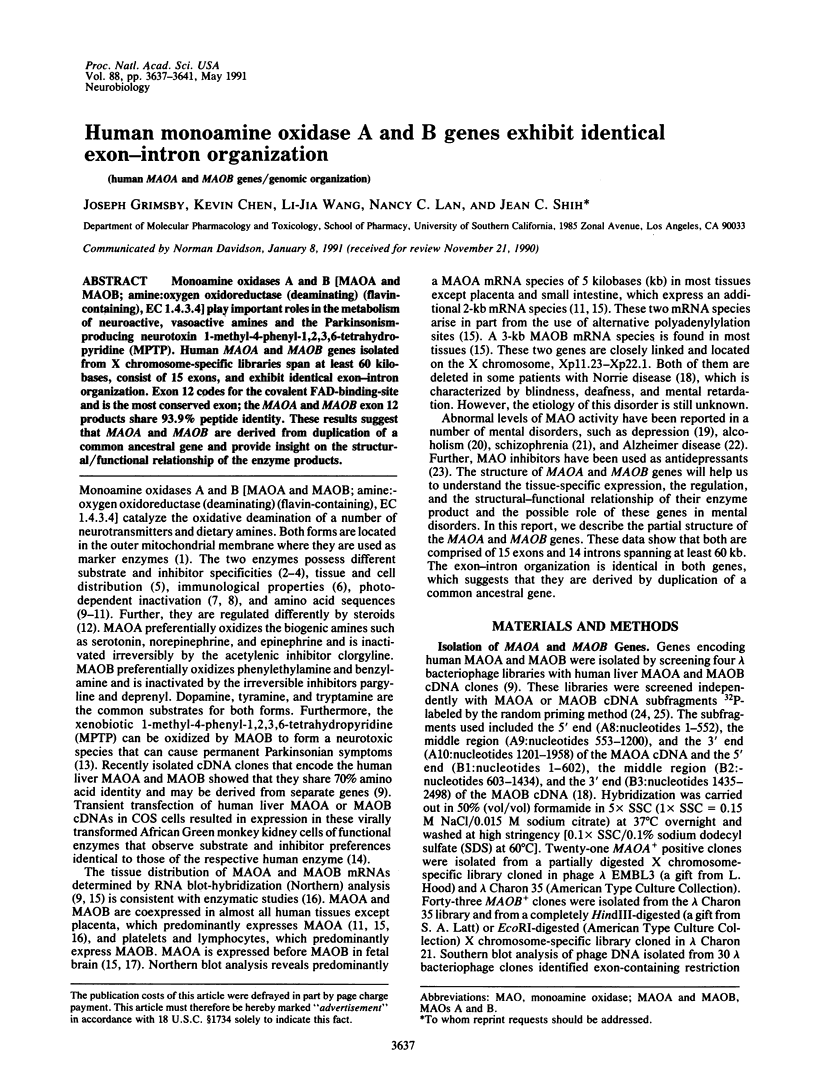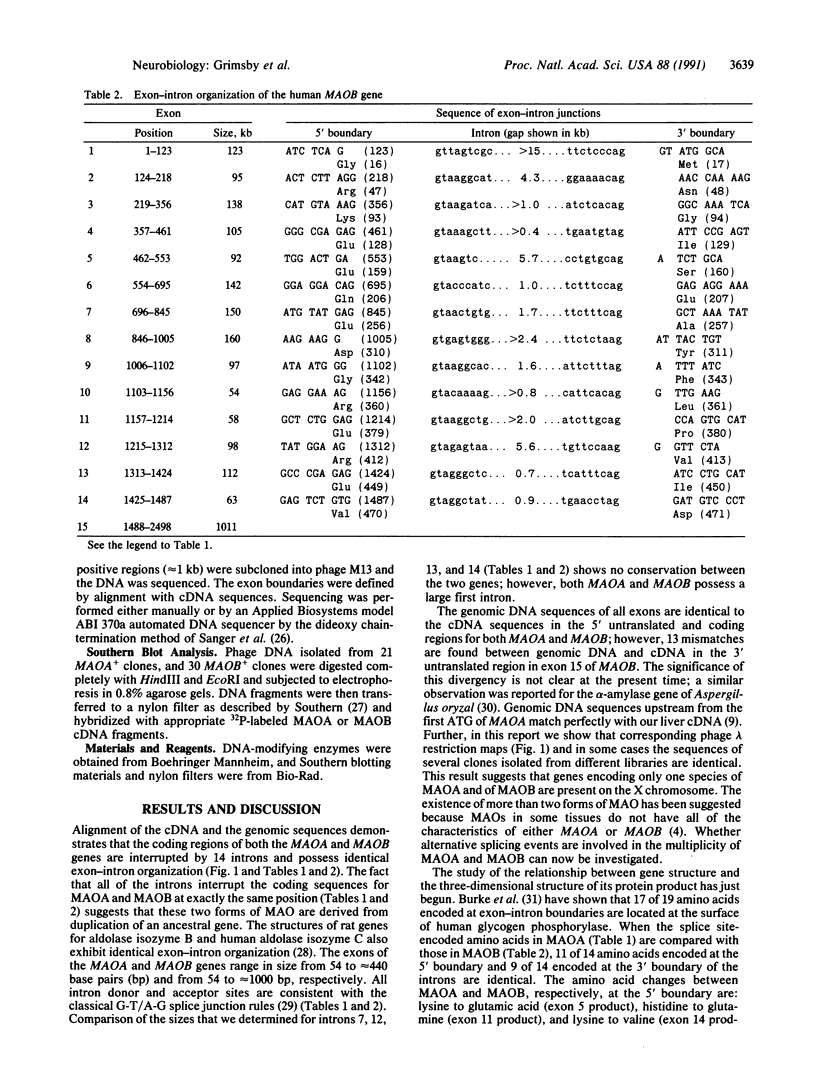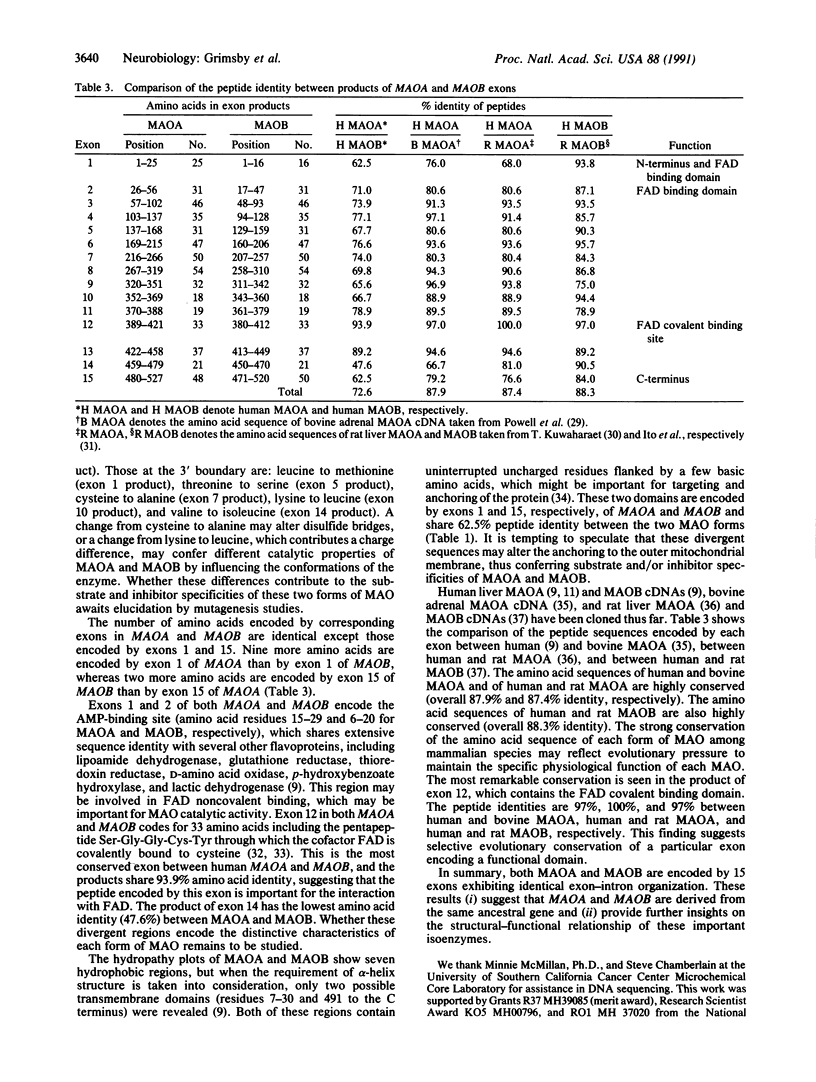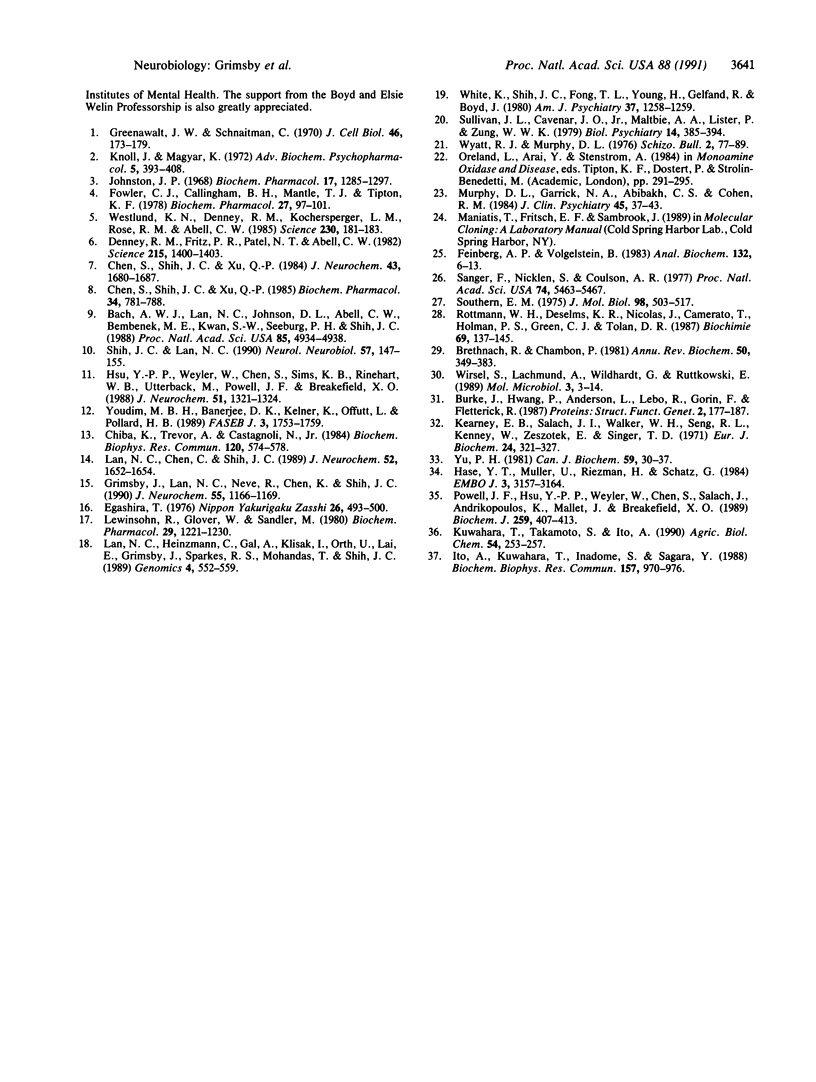Abstract
Monoamine oxidases A and B [MAOA and MAOB; amine:oxygen oxidoreductase (deaminating) (flavin-containing), EC 1.4.3.4] play important roles in the metabolism of neuroactive, vasoactive amines and the Parkinsonism-producing neurotoxin 1-methyl-4-phenyl-1,2,3,6-tetrahydropyridine (MPTP). Human MAOA and MAOB genes isolated from X chromosome-specific libraries span at least 60 kilobases, consist of 15 exons, and exhibit identical exon-intron organization. Exon 12 codes for the covalent FAD-binding-site and is the most conserved exon; the MAOA and MAOB exon 12 products share 93.9% peptide identity. These results suggest that MAOA and MAOB are derived from duplication of a common ancestral gene and provide insight on the structural/functional relationship of the enzyme products.
Full text
PDF




Selected References
These references are in PubMed. This may not be the complete list of references from this article.
- Bach A. W., Lan N. C., Johnson D. L., Abell C. W., Bembenek M. E., Kwan S. W., Seeburg P. H., Shih J. C. cDNA cloning of human liver monoamine oxidase A and B: molecular basis of differences in enzymatic properties. Proc Natl Acad Sci U S A. 1988 Jul;85(13):4934–4938. doi: 10.1073/pnas.85.13.4934. [DOI] [PMC free article] [PubMed] [Google Scholar]
- Breathnach R., Chambon P. Organization and expression of eucaryotic split genes coding for proteins. Annu Rev Biochem. 1981;50:349–383. doi: 10.1146/annurev.bi.50.070181.002025. [DOI] [PubMed] [Google Scholar]
- Burke J., Hwang P., Anderson L., Lebo R., Gorin F., Fletterick R. Intron/exon structure of the human gene for the muscle isozyme of glycogen phosphorylase. Proteins. 1987;2(3):177–187. doi: 10.1002/prot.340020303. [DOI] [PubMed] [Google Scholar]
- Chen S., Shih J. C., Xu Q. P. 4-Fluoro-3-nitrophenyl azide, a selective photoaffinity label for type B monoamine oxidase. Biochem Pharmacol. 1985 Mar 15;34(6):781–788. doi: 10.1016/0006-2952(85)90758-0. [DOI] [PubMed] [Google Scholar]
- Chen S., Shih J. C., Xu Q. P. Interaction of N-(2-nitro-4-azidophenyl)-serotonin with two types of monoamine oxidase in rat brain. J Neurochem. 1984 Dec;43(6):1680–1687. doi: 10.1111/j.1471-4159.1984.tb06095.x. [DOI] [PubMed] [Google Scholar]
- Chiba K., Trevor A., Castagnoli N., Jr Metabolism of the neurotoxic tertiary amine, MPTP, by brain monoamine oxidase. Biochem Biophys Res Commun. 1984 Apr 30;120(2):574–578. doi: 10.1016/0006-291x(84)91293-2. [DOI] [PubMed] [Google Scholar]
- Denney R. M., Fritz R. R., Patel N. T., Abell C. W. Human liver MAO-A and MAO-B separated by immunoaffinity chromatography with MAO-B-specific monoclonal antibody. Science. 1982 Mar 12;215(4538):1400–1403. doi: 10.1126/science.7063850. [DOI] [PubMed] [Google Scholar]
- Egashira T. Studies on monoamine oxidase. XVIII. Enzymic properties of placental monoamine oxidase. Jpn J Pharmacol. 1976 Aug;26(4):493–500. doi: 10.1254/jjp.26.493. [DOI] [PubMed] [Google Scholar]
- Feinberg A. P., Vogelstein B. A technique for radiolabeling DNA restriction endonuclease fragments to high specific activity. Anal Biochem. 1983 Jul 1;132(1):6–13. doi: 10.1016/0003-2697(83)90418-9. [DOI] [PubMed] [Google Scholar]
- Greenawalt J. W., Schnaitman C. An appraisal of the use of monoamine oxidase as an enzyme marker for the outer membrane of rat liver mitochondria. J Cell Biol. 1970 Jul;46(1):173–179. doi: 10.1083/jcb.46.1.173. [DOI] [PMC free article] [PubMed] [Google Scholar]
- Grimsby J., Lan N. C., Neve R., Chen K., Shih J. C. Tissue distribution of human monoamine oxidase A and B mRNA. J Neurochem. 1990 Oct;55(4):1166–1169. doi: 10.1111/j.1471-4159.1990.tb03121.x. [DOI] [PubMed] [Google Scholar]
- Hase T., Müller U., Riezman H., Schatz G. A 70-kd protein of the yeast mitochondrial outer membrane is targeted and anchored via its extreme amino terminus. EMBO J. 1984 Dec 20;3(13):3157–3164. doi: 10.1002/j.1460-2075.1984.tb02274.x. [DOI] [PMC free article] [PubMed] [Google Scholar]
- Hsu Y. P., Weyler W., Chen S., Sims K. B., Rinehart W. B., Utterback M. C., Powell J. F., Breakefield X. O. Structural features of human monoamine oxidase A elucidated from cDNA and peptide sequences. J Neurochem. 1988 Oct;51(4):1321–1324. doi: 10.1111/j.1471-4159.1988.tb03105.x. [DOI] [PubMed] [Google Scholar]
- Ito A., Kuwahara T., Inadome S., Sagara Y. Molecular cloning of a cDNA for rat liver monoamine oxidase B. Biochem Biophys Res Commun. 1988 Dec 30;157(3):970–976. doi: 10.1016/s0006-291x(88)80969-0. [DOI] [PubMed] [Google Scholar]
- Johnston J. P. Some observations upon a new inhibitor of monoamine oxidase in brain tissue. Biochem Pharmacol. 1968 Jul;17(7):1285–1297. doi: 10.1016/0006-2952(68)90066-x. [DOI] [PubMed] [Google Scholar]
- Kearney E. B., Salach J. I., Walker W. H., Seng R. L., Kenney W., Zeszotek E., Singer T. P. The covalently-bound flavin of hepatic monoamine oxidase. 1. Isolation and sequence of a flavin peptide and evidence for binding at the 8alpha position. Eur J Biochem. 1971 Dec;24(2):321–327. doi: 10.1111/j.1432-1033.1971.tb19689.x. [DOI] [PubMed] [Google Scholar]
- Knoll J., Magyar K. Some puzzling pharmacological effects of monoamine oxidase inhibitors. Adv Biochem Psychopharmacol. 1972;5:393–408. [PubMed] [Google Scholar]
- Kuwahara T., Takamoto S., Ito A. Primary structure of rat monoamine oxidase A deduced from cDNA and its expression in rat tissues. Agric Biol Chem. 1990 Jan;54(1):253–257. [PubMed] [Google Scholar]
- Lan N. C., Chen C. H., Shih J. C. Expression of functional human monoamine oxidase A and B cDNAs in mammalian cells. J Neurochem. 1989 May;52(5):1652–1654. doi: 10.1111/j.1471-4159.1989.tb09223.x. [DOI] [PubMed] [Google Scholar]
- Lan N. C., Heinzmann C., Gal A., Klisak I., Orth U., Lai E., Grimsby J., Sparkes R. S., Mohandas T., Shih J. C. Human monoamine oxidase A and B genes map to Xp 11.23 and are deleted in a patient with Norrie disease. Genomics. 1989 May;4(4):552–559. doi: 10.1016/0888-7543(89)90279-6. [DOI] [PubMed] [Google Scholar]
- Lewinsohn R., Glover V., Sandler M. Development of benzylamine oxidase and monoamine oxidase A and B in man. Biochem Pharmacol. 1980 May 1;29(9):1221–1230. doi: 10.1016/0006-2952(80)90278-6. [DOI] [PubMed] [Google Scholar]
- Mantle T. J., Tipton K. F. Monoamine oxidase A and B: a useful concept? Biochem Pharmacol. 1978 Jan 1;27(1):97–101. doi: 10.1016/0006-2952(78)90262-9. [DOI] [PubMed] [Google Scholar]
- Murphy D. L., Garrick N. A., Aulakh C. S., Cohen R. M. New contributions from basic science to understanding the effects of monoamine oxidase inhibiting antidepressants. J Clin Psychiatry. 1984 Jul;45(7 Pt 2):37–43. [PubMed] [Google Scholar]
- Powell J. F., Hsu Y. P., Weyler W., Chen S. A., Salach J., Andrikopoulos K., Mallet J., Breakefield X. O. The primary structure of bovine monoamine oxidase type A. Comparison with peptide sequences of bovine monoamine oxidase type B and other flavoenzymes. Biochem J. 1989 Apr 15;259(2):407–413. doi: 10.1042/bj2590407. [DOI] [PMC free article] [PubMed] [Google Scholar]
- Rottmann W. H., Deselms K. R., Niclas J., Camerato T., Holman P. S., Green C. J., Tolan D. R. The complete amino acid sequence of the human aldolase C isozyme derived from genomic clones. Biochimie. 1987 Feb;69(2):137–145. doi: 10.1016/0300-9084(87)90246-x. [DOI] [PubMed] [Google Scholar]
- Sanger F., Nicklen S., Coulson A. R. DNA sequencing with chain-terminating inhibitors. Proc Natl Acad Sci U S A. 1977 Dec;74(12):5463–5467. doi: 10.1073/pnas.74.12.5463. [DOI] [PMC free article] [PubMed] [Google Scholar]
- Southern E. M. Detection of specific sequences among DNA fragments separated by gel electrophoresis. J Mol Biol. 1975 Nov 5;98(3):503–517. doi: 10.1016/s0022-2836(75)80083-0. [DOI] [PubMed] [Google Scholar]
- Sullivan J. L., Cavenar J. O., Jr, Maltbie A. A., Lister P., Zung W. W. Familial biochemical and clinical correlates of alcoholics with low platelet monoamine oxidase activity. Biol Psychiatry. 1979 Apr;14(2):385–394. [PubMed] [Google Scholar]
- Westlund K. N., Denney R. M., Kochersperger L. M., Rose R. M., Abell C. W. Distinct monoamine oxidase A and B populations in primate brain. Science. 1985 Oct 11;230(4722):181–183. doi: 10.1126/science.3875898. [DOI] [PubMed] [Google Scholar]
- White K., Shih J., Fong T., Young H., Gelfand R., Boyd J., Simpson G., Sloane R. B. Elevated platelet monoamine oxidase activity in patients wth nonendogenous depression. Am J Psychiatry. 1980 Oct;137(10):1258–1259. doi: 10.1176/ajp.137.10.1258. [DOI] [PubMed] [Google Scholar]
- Wirsel S., Lachmund A., Wildhardt G., Ruttkowski E. Three alpha-amylase genes of Aspergillus oryzae exhibit identical intron-exon organization. Mol Microbiol. 1989 Jan;3(1):3–14. doi: 10.1111/j.1365-2958.1989.tb00097.x. [DOI] [PubMed] [Google Scholar]
- Wyatt R. J., Murphy D. L. Low platelet monoamine oxidase activity and schizophrenia. Schizophr Bull. 1976;2(1):77–89. doi: 10.1093/schbul/2.1.77. [DOI] [PubMed] [Google Scholar]
- Youdim M. B., Banerjee D. K., Kelner K., Offutt L., Pollard H. B. Steroid regulation of monoamine oxidase activity in the adrenal medulla. FASEB J. 1989 Apr;3(6):1753–1759. doi: 10.1096/fasebj.3.6.2495232. [DOI] [PubMed] [Google Scholar]
- Yu P. H. Studies on the pargyline-binding site of different types of monoamine oxidase. Can J Biochem. 1981 Jan;59(1):30–37. doi: 10.1139/o81-005. [DOI] [PubMed] [Google Scholar]


